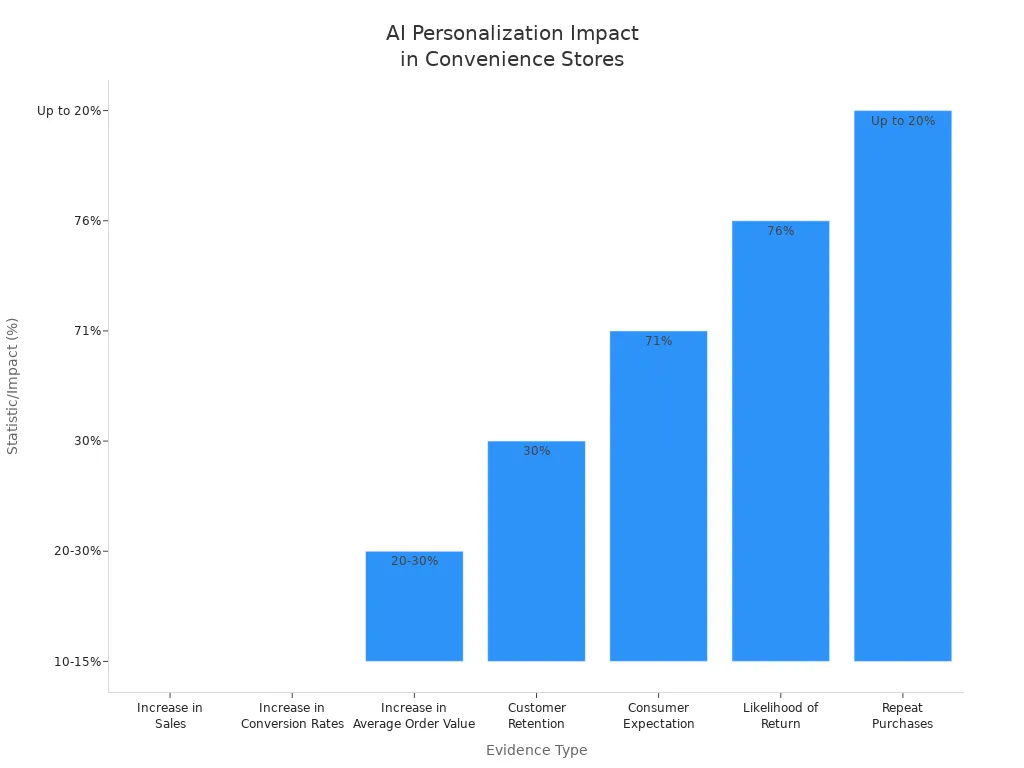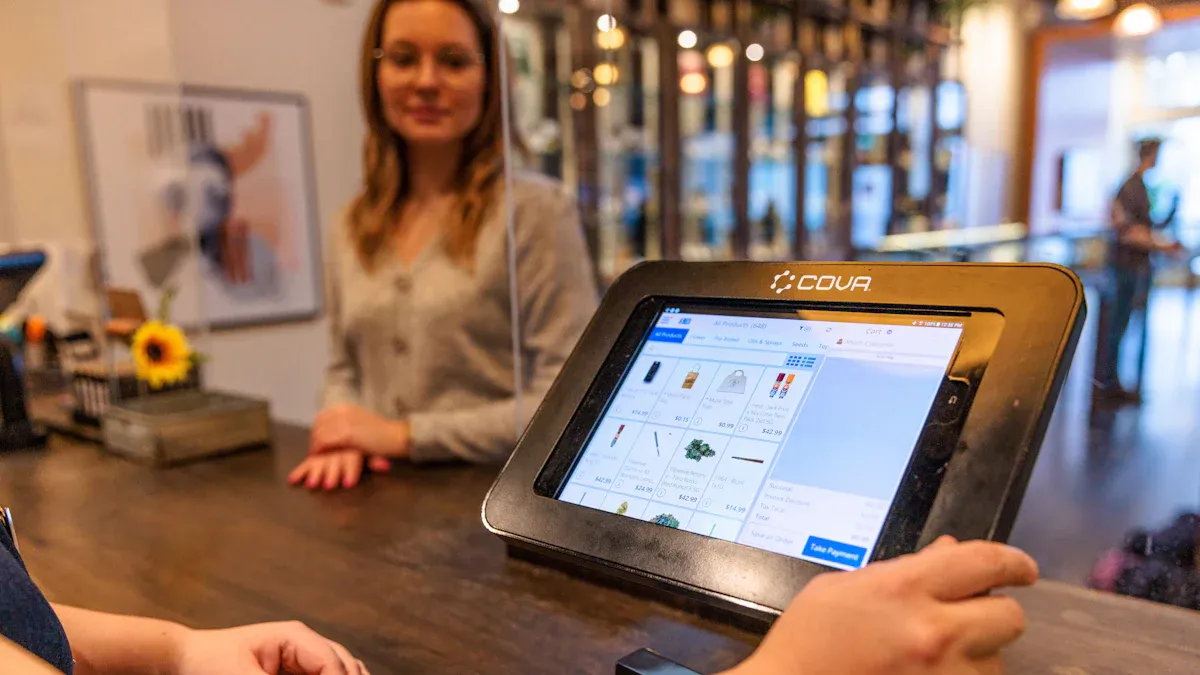What’s Next for AI Store Use Cases in the Convenience Industry

You see AI store use cases changing your store every day. New technology helps you make good choices and manage inventory easily. You notice fewer times when items run out. You also see less extra stock sitting around. Automation now does many simple jobs for you. This means you need fewer workers to keep things going. Customers get faster checkout and special deals just for them. The table below shows how AI tools help your store work better:
Evidence Description | Impact on Operational Efficiency |
|---|---|
Cuts down on running out of items and having too much stock | |
Automation streamlines routine operations | Lowers the need for workers and saves money |
AI-driven POS systems improve customer experience | Gives customers special offers and quicker checkout |
AI predicts inventory demand patterns | Helps stores have the right items at the right time |
AI optimizes inventory management | Makes stores work better, no matter their size |
You have real chances to make your business better by using these new tools.
Key Takeaways
AI tools help stores know what items people will buy. This stops running out of things and having too much extra stock.
Stores use machines like self-checkout to make buying faster. This means workers do not have to do as much. Customers are happier because they wait less.
AI helps stores give shoppers deals just for them. This makes people want to come back and buy more.
AI security systems watch the store all the time. They help stop stealing and keep everyone safe.
Teaching workers how to use AI tools makes them feel sure of themselves. This helps the store run better.
AI Store Use Cases Today

AI store use cases have already changed how you run your convenience store. You now use new tools to help with tasks, inventory, and customers. These tools make your store work better and keep people happy.
Automation
You can now use machines to do jobs that took a lot of time. Automated checkout lets customers scan and pay by themselves. This means you need fewer workers at the register. It also saves money on paying workers. Self-checkout lets many people pay at once. This makes lines shorter and customers leave faster.
AI-powered systems do more than help with checkout. They help keep your store safe and your food fresh. Some systems watch the aisles for strange movements to stop theft. Others check food temperatures and dates to keep things safe.
Here are some AI-powered automation solutions you might use:
Give customers special deals made just for them.
Watch for strange movements to keep the store safe.
Help keep food safe and fresh.
You can also use tools like Vynamic Smart Vision®. This system helps in many ways:
AI Solution | Functionality | Benefits |
|---|---|---|
Vynamic Smart Vision® | Shrink Reduction | Watches aisles, finds odd behavior, and spots missed scans. |
Vynamic Smart Vision® | Multi-Item Recognition | Sees many products at checkout, making things faster. |
Vynamic Smart Vision® | Age Verification | Checks ages for certain items, so you follow the rules. |
You might also use tools for fuel prices, digital shelf tags, and AI to watch store activities. These tools help your store run well and keep customers happy.
Inventory Management
Before, managing inventory meant guessing a lot. Now, AI helps you keep the right amount of stock. AI can cut mistakes in the supply chain by half. This means fewer empty shelves and less wasted stock. Stores using AI have 30% fewer times with no stock and up to 50% lower costs for holding extra items.
You can use AI to:
Guess what people will buy and order more before you run out.
Watch your stock all the time and see what sells slowly.
Stop having too much extra stock by knowing what people want.
Big brands use AI to match stock with what people nearby want. H&M uses AI to guess what will sell and not order too much. Zara’s AI only restocks popular items, so there is less extra stuff. Amarra used AI to cut extra stock by 40% and still had enough of what people wanted.
You might use Trax, which uses AI to look at pictures of your shelves. Trax tells you what is in stock and helps you follow sales plans. It also uses machine learning to study sales and customer habits, so you can keep the right items.
Customer Service
AI store use cases also help you serve customers better. AI chatbots and helpers answer questions right away. Customers do not have to wait for help. These tools answer easy questions, so workers can do other jobs. Customers get help fast and feel happier.
AI customer service tools work all day and night. Customers can get help even when the store is closed. These tools also make shopping personal. For example, they suggest products your customers might like. This makes shopping easier and can make people come back.
Here are some ways AI helps customer service:
AI chatbots answer customer questions right away.
They handle easy questions, so answers come faster.
AI tools help customers any time, day or night.
Shopping feels more personal, so customers may return.
Some stores use advanced AI, like Amazon Go’s checkout with no cashiers. It uses cameras and sensors to track what people buy. Walmart’s smart shelves tell workers when to restock, so customers find what they need. Nike and Nordstrom use chatbots to answer questions and suggest products.
AI store use cases today help you do jobs faster, manage stock, and help customers. These tools make your store work better and keep customers coming back.
Emerging AI Trends
You notice new AI trends changing how you run your store. These trends help you serve customers better. They also help keep your store safe. You can make smarter choices every day. Let’s see the most important trends for the future.
Personalization
Personalization uses AI to give each customer a special shopping trip. You can suggest products based on what customers bought before. You can also suggest what is popular in your area. AI can use local events or social media trends to make better picks. When you use personalization, customers find what they want faster. This makes them feel important.
Tip: Personalization can help you sell more and keep customers coming back.
Here is how personalization helps your store:
Evidence Type | Statistic/Impact |
|---|---|
Increase in Sales | |
Increase in Conversion Rates | 10-15% increase in conversion rates |
Increase in Average Order Value | 20-30% increase in average order value |
Customer Retention | 30% increase in customer retention |
Consumer Expectation | 71% of consumers expect personalized experiences |
Likelihood of Return | 76% of consumers are more likely to return |
Repeat Purchases | Up to 20% increase in repeat purchases |

Many big brands use AI for personalization. Amazon uses AI to show products people may like. This helps them sell more. Sephora gives special rewards, so customers stay loyal. You can use these ideas in your store to make shopping better.
Predictive Analytics
Predictive analytics helps you make smart choices about what to stock. It also helps you know how to price items. AI looks at past sales and market trends. It even checks the weather to guess what people will buy next. You can use this to keep shelves full and avoid running out.
Here are some ways predictive analytics helps your store:
Look at sales data to find busy times.
Change your product mix to match what people want.
Change prices fast to stay ahead and make more money.
Use demand forecasting to order the right amount.
Measurable Outcome | Description |
|---|---|
Demand Forecasting | Optimizes inventory levels, reduces stockouts, and prevents overstock situations. |
Customer Segmentation | Enables personalized marketing strategies, improving customer engagement and retention. |
Personalized Recommendations | Enhances shopping experience and drives upselling through tailored product suggestions. |
Optimized Pricing Strategies | Allows for dynamic pricing adjustments based on market demand and competitor pricing. |
Inventory Management | Minimizes overstock and stockouts, ensuring product availability and reducing holding costs. |
Enhanced Promotional Strategies | Identifies effective promotions, boosting engagement and conversion rates. |
Improved Customer Service | Personalizes interactions, leading to higher customer satisfaction and loyalty. |
Market Trend Analysis | Helps in proactive adjustments to product offerings and marketing strategies. |
Optimized Store Expansion | Aids in identifying optimal locations for new stores based on data analysis. |
Starbucks uses predictive analytics to change prices on digital menus. This helps them react to changes and make more money. You can use tools like this to keep your store ahead.
Autonomous Checkout
Autonomous checkout lets customers pay without waiting in line. You can use self-checkout kiosks or mobile apps to scan and pay. These systems use AI, cameras, and sensors to track what people buy. This makes shopping faster and easier.
Self-checkout may handle almost 40% of all retail sales by 2026.
Shoppers like quick checkouts, so scan-and-go apps are growing.
Stores like Żabka and Sam’s Club use AI-powered checkout to make shopping smooth.
New computer vision and sensors make these systems better and cheaper. You can now offer checkout with no cashiers. This saves time for you and your customers.
Note: Autonomous checkout can make shopping easier, but you need to watch for more theft. AI can help by checking for missed scans and warning staff.
Metric | Self-Checkout | Staffed Checkout | Comparison |
|---|---|---|---|
Shrinkage rate (% of inventory) | 3.75% | N/A | Up to 4 times higher at self-checkout |
Theft frequency | 4 times as often | Baseline | Theft occurs about 4x more at self-checkout kiosks |
Loss rate for retailers with self-checkout | 4% | ~2% (industry average) | About double the loss rate compared to retailers without self-checkout |
Contribution to unknown store losses | Up to 23% | N/A | Self-checkout accounts for nearly a quarter of unknown losses |
Portion of self-checkout losses that are intentional theft | 48% | N/A | Nearly half of self-checkout losses are intentional theft |
Security
AI-powered security keeps your store safe. You can use smart cameras and facial recognition to spot trouble. These systems watch for theft and warn you right away. They can even know shoplifters by face. AI can also guess when and where problems might happen, so you can act fast.
Here are some top security tools you can use:
Technology Type | Description |
|---|---|
AI-powered Cameras | Analyze real-time video to spot suspicious actions and known offenders. |
Facial Recognition Technology | Compares faces to a database of shoplifters and alerts you instantly. |
Real-time Monitoring | Lets you watch live video on your phone for quick decisions. |
Automated Alerts | Sends alerts when the system sees something unusual. |
Predictive Analytics | Looks for patterns in behavior to find possible threats. |
AI surveillance systems can cut theft by up to 90%. They spot hiding and loitering early and send instant alerts to your team.
Stores like Walmart and Amazon Go use AI cameras to stop theft and fix checkout mistakes. Home Depot uses facial recognition to catch repeat offenders. These tools help you protect your store and your profits.
You can use these new trends to make your store smarter and safer. You can also make your store more profitable. By using new ai store use cases, you get ready for the future. You also give your customers the best experience.
AI and Operations
Employee Experience
You can use AI to make your employees’ work lives better. AI helps you create work schedules that fit each person’s needs. It looks at attendance and performance to spot who might leave soon. This lets you act early and keep your best workers. When you use AI, you can also train cashiers better and help them feel more engaged. Happy workers often give better service and stay longer.
Here is how AI streamlines store operations:
Application Area | Description |
|---|---|
Real-time Insights | AI checks how customers and employees interact to find ways to improve. |
Employee Engagement | AI gives tips for training and keeping workers happy. |
Compliance Monitoring | AI watches store processes to make sure you follow all rules. |
Supply Chain
AI helps you keep your shelves full and cut down on waste. You can use AI to track sales and stock levels. It tells you which items sell fast and which do not. AI suggests how much to order and when, so you do not run out or overstock. You get alerts when stock is low, so you can act quickly.
AI uses past sales and outside factors to guess what you will need.
It orders new stock at the right time to avoid shortages.
AI recommends how much to order based on shelf life and local demand.
You can adjust for seasons and trends, so you waste less.
Stores like Wawa use AI to manage perishable items and reduce spoilage.
Consistent product availability builds trust with your customers. AI-driven inventory management helps you save money and keep shoppers happy.
Energy Management
AI can help you save energy and lower costs. It controls heating and cooling based on how many people are in the store and the weather outside. AI finds problems with equipment before they get worse, which can save you thousands of dollars. It balances how hard each machine works, so they last longer.
AI adjusts temperatures to save energy.
Automated systems help you avoid high energy charges.
You can check and control systems from anywhere, which saves on technician visits.
AI helps you use less energy and meet your sustainability goals.
You see these ai store use cases making your store more efficient and cost-effective every day.
AI for Customer Experience

Real-Time Assistance
AI can help customers right away. Chatbots answer questions fast, so people do not wait. These bots suggest products based on what shoppers buy. Customers get help any time, even after the store closes. AI learns from what people buy and gives special offers just for them. This makes shopping easier and more fun.
AI looks at what people buy and suggests new snacks or drinks.
Loyalty programs change to fit how each person shops.
Chatbots give quick answers about products or store hours.
AI checkout systems can see many items at once. This makes paying faster and keeps lines short. Customers finish shopping quickly and leave happy.
Application | Benefit |
|---|---|
Personalized Recommendations | Shows shoppers products they might like, so they buy more. |
Inventory Management | Keeps shelves full and ready for busy times. |
Automated Interactions | Lets chatbots help customers quickly and easily. |
Omnichannel Integration
AI connects your store’s online and in-person shopping. Customers can shop when and how they want. You use data to give each person special deals and product ideas. AI tracks inventory, so you always know what is in stock. Shoppers get help from chatbots any time, and there are fewer order mistakes.
Benefit | Description |
|---|---|
Personalized Shopping Experiences | AI uses data to give each shopper deals and product ideas they want. |
Seamless Integration of Online and Physical Shopping | Customers shop online or in-store, making shopping easy and flexible. |
Enhanced Inventory Management | AI keeps track of products, so shelves stay stocked and orders are correct. |
Improved Customer Service | Chatbots and AI tools help customers day and night, making service better. |
AI guesses what customers need and helps you keep them coming back.
Chatbots answer questions all day, so shoppers do not have to wait.
Sentiment tools show how happy customers feel right now.
Loyalty Programs
AI can make loyalty programs smarter. AI gives instant offers when customers look at products. This makes people want to buy more. AI also sees when someone might stop shopping at your store. You send special deals to keep them coming back. Studies show people spend 37% more when stores make their experience personal.
AI loyalty programs send offers based on what each person likes.
You keep your best customers by sending deals when they might leave.
Special rewards make shoppers feel important and spend more.
You see ai store use cases like these help you build strong customer relationships and boost sales.
Challenges and Adoption
Data Privacy
You have to think about data privacy when using AI. Many customers worry about their personal information. For example, 58% of people worry about how AI uses their data. Also, 28% do not trust any company with their data. AI systems collect a lot of data. This can be risky if you do not protect it well. You must keep customer data safe from hackers. Some places have strict privacy laws, but others do not. You need to know the rules where your store is.
Too much data is kept without strong privacy rules. Some countries have strict laws, like the European Union’s GDPR. Other places may let the government or other groups see data without much control.
You should be open about how you use and protect customer data. This helps build trust.
Integration
It can be hard to add AI to your store. You need to connect new tools to your old systems. Sometimes, you must change your software or hardware. AI has to work well in busy stores. You also need strong computers to handle data fast.
Challenge | Description |
|---|---|
Accuracy of Computer Vision Systems | You must make sure AI can spot products and watch what customers do. |
Real-Time Processing and Analysis | You need fast computers to handle data and give quick results. |
Integration with Existing Systems | You may need to upgrade your IT to connect AI with your current tools. |
Handling Dynamic Environments | AI must learn and change as your store changes, which can be hard. |
Customer Interactions and Behavior Analysis | AI needs to understand many customer actions, so you must train it with lots of examples. |
You should think about these problems before you start using AI.
Cost and ROI
You want to know if AI is worth the cost. Most store owners see good results. Almost 90% of convenience stores use or test AI. You can expect that 87% say AI helps them make more money. Also, 94% say it lowers costs. AI can help you sell more by up to 15% with better layouts. Personalization with AI can boost sales by 5% to 10%.
AI can help you save money and make more sales. You should look at your costs and benefits before you buy AI. If you plan well, you can get a good return on your money.
Preparing for AI Store Use Cases
Readiness
You can get your store ready for new AI tools by following a few important steps. Start by looking closely at your supply chain. Find places where you can do better. Protect your customer data with strong security, like encryption and access controls. Build relationships with trusted vendors who know AI. Try out small pilot projects before you use AI everywhere. Encourage your team to use data when making decisions. Keep improving your AI systems as you learn more.
Audit your supply chain to spot areas for improvement.
Use strong security to keep customer data safe.
Work with vendors who can help you add AI to your store.
Test AI with small projects first.
Teach your team to use data for decisions.
Update your AI tools as you get feedback.
Tip: Starting small with pilot projects helps you see what works best for your store.
Partnerships
You do not have to do everything alone. Partnering with AI vendors and technology experts can make things easier. These partners can help you choose the right tools and set them up. They can also train your staff and offer support when you need it. Good partnerships help you keep up with new trends and updates in ai store use cases.
Choose partners with experience in retail AI.
Look for vendors who offer training and support.
Build long-term relationships for ongoing success.
Training
Training your staff is key to making AI work well in your store. AI can create fun and helpful training materials. You can give each worker a learning path that fits their needs. Use simulations to help your team practice real-life situations. AI tracks how well your team learns and gives feedback right away. This helps you find and fix any gaps in knowledge.
Training Feature | Description |
|---|---|
Immersive content generation | AI helps make engaging training materials. |
Tailored learning approach | Each worker gets a learning path that fits them. |
Simulated experiences | Staff can practice real-life tasks in a safe way. |
Real-time feedback | AI gives instant feedback to help workers improve. |
Data-driven insights | You see reports on who is doing well and who needs more help. |
Note: When you invest in training, you help your team feel confident and ready for new technology.
You notice AI is making convenience stores different all the time. Personalization, predictive analytics, and autonomous checkout are some of the main changes. These tools help you take care of customers and make your store work better. Keep an open mind and learn about new AI ideas. Spend money on training and new tech to stay ahead.
Tip: Try out small changes first and see what works. Test new things and watch your store get better. Be ready for new AI changes by trying new ideas now.
FAQ
What is the easiest way to start using AI in my store?
You can start with AI-powered inventory tools or self-checkout systems. These options need little training. They help you see quick results. Try a small pilot project first.
How does AI help reduce theft in convenience stores?
AI uses smart cameras and sensors to watch for suspicious actions. You get instant alerts if something looks wrong. This helps you stop theft before it happens.
Will AI replace my employees?
AI handles simple, repetitive tasks. Your employees can focus on helping customers and solving problems. You still need people for jobs that need a human touch.
Is AI expensive for small stores?
Some AI tools cost less than you think. Many vendors offer monthly plans. You can choose what fits your budget. Start small and grow as you see results.
How do I keep customer data safe when using AI?
Use strong passwords and encryption. Work with trusted vendors who follow privacy laws. Always tell customers how you use their data.
See Also
The Future of Retail Lies in AI-Driven Stores
Understanding the Growth of AI-Enhanced Corner Shops
Smart Stores: The Future of Convenience Shopping Awaits
